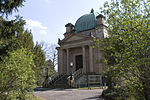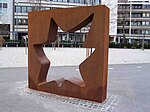Peter Cornelius Conservatory
1882 establishments in GermanyMusic schools in Germany

The Peter Cornelius Conservatory (Peter-Cornelius-Konservatorium der Stadt Mainz, PCK) is the conservatory in Mainz, the capital of the German state Rhineland-Palatinate. It dates back to a first conservatory founded around 1882. It is named after the composer Peter Cornelius who was born in Mainz. It trains both professionals and amateurs, focused of the interplay of both aspects of music-making.
Excerpt from the Wikipedia article Peter Cornelius Conservatory (License: CC BY-SA 3.0, Authors, Images).Peter Cornelius Conservatory
Binger Straße, Mainz Hartenberg-Münchfeld
Geographical coordinates (GPS) Address Nearby Places Show on map
Geographical coordinates (GPS)
| Latitude | Longitude |
|---|---|
| N 49.999 ° | E 8.2569722222222 ° |
Address
Piano Alexander
Binger Straße 18
55122 Mainz, Hartenberg-Münchfeld
Rhineland-Palatinate, Germany
Open on Google Maps









